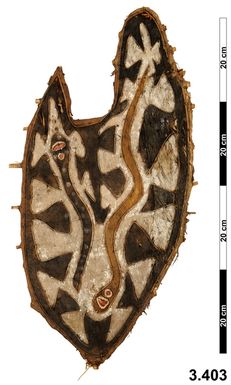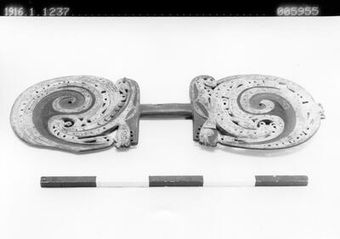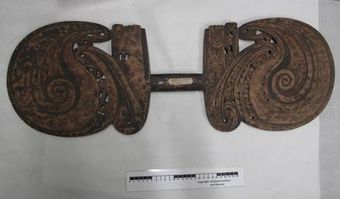Connect with Horniman Museum and Gardens
Contact this content partner to get more information about this item.
dance shield
- Description:
- Dance Shield, Elema People, Orokolo, Gulf Province, Papua New Guinea. Dance shields of this type are not common in museum collections, and were never very common in the Papuan Gulf. They mimic the shape of wooden shoulder shields worn underarm by archers in this region of New Guinea, and were worn by men as an ornamental prop during their dances. The snake was a powerful symbol in the Papuan Gulf, where some of the world’s most venomous species (certain taipans and kraits) live. For the Elema, the snake embodies the evil spirit Ove-Hahu, who causes accidents, snakebites and other sudden severe illnesses. To die from a snake bite was viewed as the least dignified death, at the opposite pole to a warrior’s death in battle. Although Elema shields usually feature symbols of the warrior’s clan, here we might interpret the artist as creating a defiant and mocking theme to his imaginary enemy. Bamboo, banana leaf, barkcloth, pigment, vegetable fibre. Late 19th Century. Purchased by the Horniman Museum from the art dealer Mr S. G. Fenton in 1903. Dance shield of asymmetrical heart shape, one top lobe is rounded and high, the other pointed and low. The frame of the shield is made from grid of split cane and the whole shield is edged with the same. To this scaffold are tied with pandanus (?) fibre several sago leaves which are then overlaid with a coarse barkcloth. To this barkcloth are stitched thin leaf mid ribs to create zones which have then been painted in a chocolate brown and white. The design depicts two snakes, one going up the other going down, surrounded by rounded dovetail forms.
- Format:
- image
- Collections:
- Horniman Museum and Gardens
- Content partner:
- Horniman Museum and Gardens
- Availability:
- Not specified
-
Copyright status: All rights reservedFind out more about what you are able to do with this itemThis item is all rights reserved, with means you'll have to get permission from Horniman Museum and Gardens before using it. For more information, please see our use and reuse page.More informationHorniman Museum and Gardens has this to say about the rights status of this item:
http://rightsstatements.org/vocab/InC/1.0/
What can I do with this item?Non-infringing useNZ copyright law does not prevent every use of a copyright work, and this item may be hosted by an international institute or organisation. You should consider what you can and cannot do with a copyright work.No sharingYou may not copy and/or share this item with others without further permission. This includes posting it on your blog, using it in a presentation, or any other public use.No modifyingYou are not allowed to adapt or remix this item into any other works.No commercial useYou may not use this item commercially.
Welcome and warm Pasifik greetings
The information on this site has been gathered from our content partners.
The names, terms, and labels that we present on the site may contain images or voices of deceased persons and may also reflect the bias, norms, and perspective of the period of time in which they were created. We accept that these may not be appropriate today.
If you have any concerns or questions about an item, please contact us.



